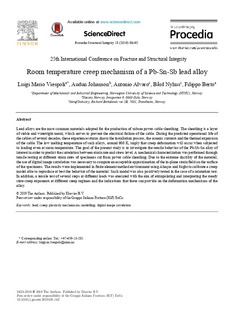| dc.contributor.author | Viespoli, Luigi Mario | |
| dc.contributor.author | Johanson, Audun | |
| dc.contributor.author | Alvaro, Antonio | |
| dc.contributor.author | Nyhus, Bård | |
| dc.contributor.author | Berto, Filippo | |
| dc.date.accessioned | 2019-09-17T08:00:48Z | |
| dc.date.available | 2019-09-17T08:00:48Z | |
| dc.date.created | 2019-09-10T07:59:40Z | |
| dc.date.issued | 2019 | |
| dc.identifier.issn | 2452-3216 | |
| dc.identifier.uri | http://hdl.handle.net/11250/2617118 | |
| dc.description.abstract | Lead alloys are the most common materials adopted for the production of subsea power cable sheathing. The sheathing is a layer of stable and watertight metal, which serves to prevent the electrical failure of the cable. During the predicted operational life of the cables of several decades, these experience strains due to the installation process, the oceanic currents and the thermal expansion of the cable. The low melting temperature of such alloys, around 600 K, imply that creep deformation will occur when subjected to loading even at room temperature. The goal of the present study is to investigate the tensile behavior of the Pb-Sb-Sn alloy of interest in order to predict the correlation between strain rate and stress level. A mechanical characterization was performed through tensile testing at different strain rates of specimens cut from power cable sheathing. Due to the extreme ductility of the material, the use of digital image correlation was necessary to compute an acceptable approximation of the in-plane strain field on the surface of the specimens. The results were implemented in finite element method environment using Abaqus and Isight to calibrate a creep model able to reproduce at best the behavior of the material. Such model was also positively tested in the case of a relaxation test. In addition, a tensile test of several steps at different loads was executed with the aim of extrapolating and interpreting the steady state creep exponents at different creep regimes and the indications that these can provide on the deformation mechanisms of the alloy. | nb_NO |
| dc.language.iso | eng | nb_NO |
| dc.publisher | Elsevier | nb_NO |
| dc.rights | Attribution-NonCommercial-NoDerivatives 4.0 Internasjonal | * |
| dc.rights.uri | http://creativecommons.org/licenses/by-nc-nd/4.0/deed.no | * |
| dc.title | Room temperature creep mechanism of a Pb-Sn-Sb lead alloy | nb_NO |
| dc.type | Journal article | nb_NO |
| dc.type | Peer reviewed | nb_NO |
| dc.description.version | publishedVersion | nb_NO |
| dc.source.journal | Procedia Structural Integrity | nb_NO |
| dc.identifier.doi | 10.1016/j.prostr.2019.08.142 | |
| dc.identifier.cristin | 1723042 | |
| dc.description.localcode | © 2019 The Author(s). Published by Elsevier B.V. This is an open access article under the CC BY-NC-ND 4.0 license. | nb_NO |
| cristin.unitcode | 194,64,92,0 | |
| cristin.unitname | Institutt for maskinteknikk og produksjon | |
| cristin.ispublished | true | |
| cristin.fulltext | original | |
| cristin.qualitycode | 1 | |

